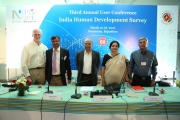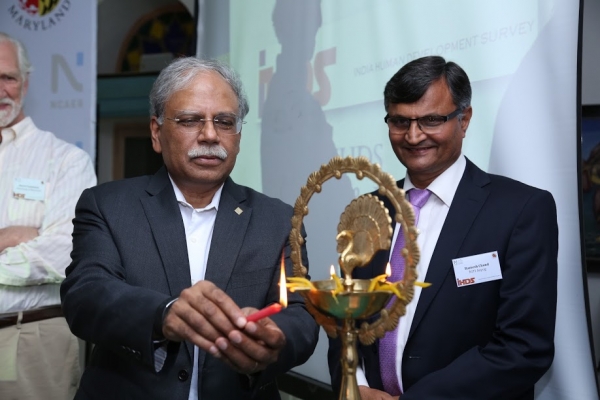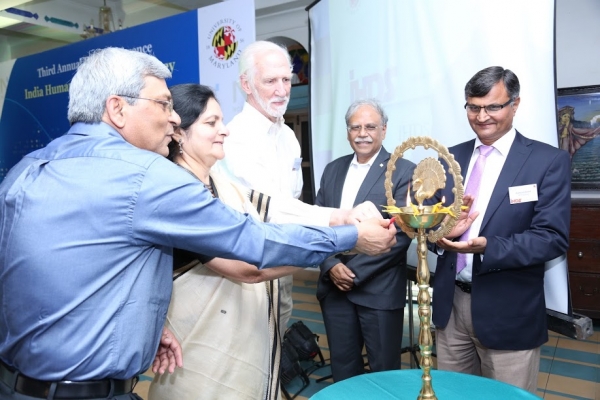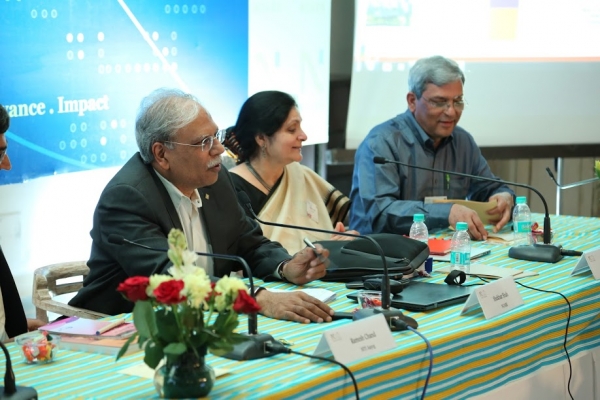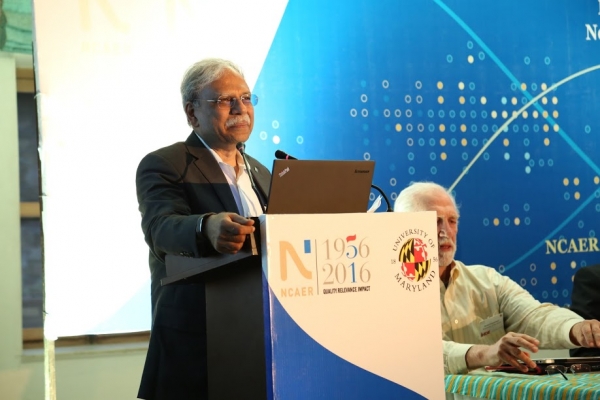NCAER formally launched the public-use India Human Development Survey-II (IHDS-II) data, India’s first national, multi-topic, longitudinal household panel survey, at the start of the Third IHDS Users’ Conference at the Neemrana Fort Palace, Rajasthan. A training session was also held on March 16th in conjunction with the conference for students and scholars working with IHDS data. The conference, based on data from IHDS-I of 2004-05 as well as some of the early access files of 2011-12, featured papers on a wide range of economic, sociological and political transformations in India over the past decade and provided an insight into the changes that India has experienced in the twenty-first century.
IHDS is the first large-scale national panel survey of over 40,000 Indian rural and urban households undertaken by researchers from NCAER and the University of Maryland, College Park, USA, in a long-standing partnership. It covers the full spectrum of health, education, economic, family and gender modules based on both urban and rural samples, and provides data to re-conceptualise development and to spur research on India’s social and economic transformation. Longitudinal panel data—tracking the same household over long periods of time—is particularly valuable because researchers and analysts can make inferences with far greater confidence and trace the long-term impact of economic and social policies.
The IHDS contains data on a wide range of topics such as income, expenditure, employment, morbidity, health expenditure, marriage, fertility and education. It is also the only source of data on marriage patterns in India, and has proven to be extremely useful in studies of family formation and intra-household dynamics. The project has wide support from a number of funders, including five grants from the US National Institutes of Health, and from the World Bank, the Ford Foundation, and DFID, UK.
The IHDS surveys have been conducted with broad support from the former Planning Commission and are guided by an advisory panel consisting of eminent academics and ministry representatives and chaired by Dr Pronab Sen, India’s first Chief Statistician. NITI Aayog has enthusiastically continued this support to IHDS. Dr Ramesh Chand, Member, NITI Aayog, in his keynote address at the launch at Neemrana, commented, “The India Human Development Survey data contain valuable information on all aspects of human development available at one place. The panel data will reveal the direction and magnitude of the socio-economic changes taking place in India. I feel IHDS will provide very rich material to researchers, and contribute to strong evidence-based policy making.”
The core strength of IHDS lies in its ability to generate panel data surveying the same households over time. The foundations of IHDS lie in work NCAER had done in 1993-94 as part of its Human Development Profile of India (HDPI). The IHDS-I rural sample used about a third of the HDPI households. IHDS-I data were collected in 2004-05 from 41,554 households with 215,751 individuals and located in 1,503 villages and 971 urban blocks all across India. This was repeated in 2011-12 for IHDS-II, when the same households were revisited, with a high re-contact rate of 83 per cent after seven years.
Dr Shekhar Shah, Director-General, NCAER, opened the IHDS Users Conference and emphasised the rich analytical possibilities that this data offers and the impact it has already had. “The IHDS surveys are available free to researchers worldwide. IHDS data are filling a clearly felt need, as evidenced by the fact that more than 7,000 researchers globally are using these data; over 205 scientific papers have been published using just IHDS-I. With the release of IHDS-II, we anticipate an even greater interest,”
Dr Shah added, “IHDS-II is currently ranked second in the list of top downloads in the past six months from ICPSR, and IHDS-I is fourth. This is an amazing endorsement of the IHDS, since the ranking includes all US databases on ICPSR. The next non-US database on this list is at a distant 10th place. So, you can imagine the level of interest that the IHDS data are generating. Just the five themes at this Users Conference, which actually only scratch the surface, show the rich possibilities in assessing the success or failure of Indian public policy in promoting development.”
Dr Sonalde Desai, IHDS Project Leader and Senior Fellow at NCAER and Professor at the University of Maryland, pointed out an inherent problem with use of data collected at a single point in time for informing public policy. She noted, “Our public policies have historically focused on individuals who are poor by virtue of the accident of their birth – dalits, adivasis, and individuals based in poor states and backward districts. But with declining poverty, the accident of birth has become less important than the accident of life. People fall into poverty due to illness, drought, declining opportunities in agriculture, and urban blight.”
Policies that label individuals as poor on the basis of Below the Poverty Line (BPL) surveys often mis-target. In a rapidly changing economy, BPL censuses undertaken only once in ten years tend to miss the mark. IHDS data shows that only 13 per cent of the population was poor in both 2004-05 and 2011-12, and this is the population most likely to be served by the present policies; 53 per cent of the people were poor in neither of the two periods and 25 per cent moved out of poverty between 2004-05 and 2011-12. The worrying finding, however, is that 9 per cent of the population fell into poverty. This suggests that if we were to provide safety nets in 2011-12 based on a BPL card issued in 2004-05, 65 per cent of the BPL card holders would have already moved out of poverty (reflecting an error of inclusion), but of those poor in 2011-12, 40 per cent would not have a BPL card since they fell into poverty after the BPL survey (reflecting errors of exclusion). The vulnerability of this last group has, unfortunately, received little attention. “As Latin American countries have found, moving to middle income levels also means fostering a middle-income mindset for drafting social policies, with a greater focus on vulnerability instead of concentrating solely on chronic poverty,” said Dr Desai.
Professor Reeve Vanneman, University of Maryland, pointed out, “Given India’s massive policy innovations, longitudinal research can examine the ‘before’ and ‘after’ outcomes for participants and non-participants alike. National longitudinal data provides the big picture for evidence-based policy design. The decentralisation of programmes such as Integrated Child Development Services and massive experiments such as MGNREGA and Rashtriya Swasthya Bima Yojana or RSBY have promising implications for development policies around the world. IHDS will help us all to understand their impacts.”
Professor Amaresh Dubey from Jawaharlal Nehru University suggested that access to multi-topic surveys like IHDS reshapes academic discourse by allowing students as well as senior researchers to examine linkages between economic and social transformations.
The formal global launch of the IHDS-II public use data in 2016 is one of the events celebrating NCAER’s 60th Anniversary Year.
In addition to the data launch, a workshop-cum-training session was also held at the commencement of the Conference to facilitate the more effective use of IHDS data by both existing and potential users. The training session was coordinated by the Principal Investigators (PIs) of the project, Dr Sonalde Desai, Professor Amaresh Dubey and Professor Reeve Vanneman. Subsequently, a wide range of papers were presented at the Conference, based on data from IHDS-I of 2004-05 as well as some of the early access files of 2011-12, featuring the economic, sociological and political transformations in India over the past decade and providing an insight into the changes India has experienced in the twenty-first century.






